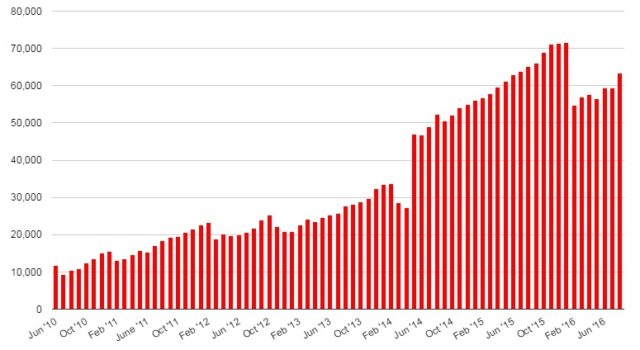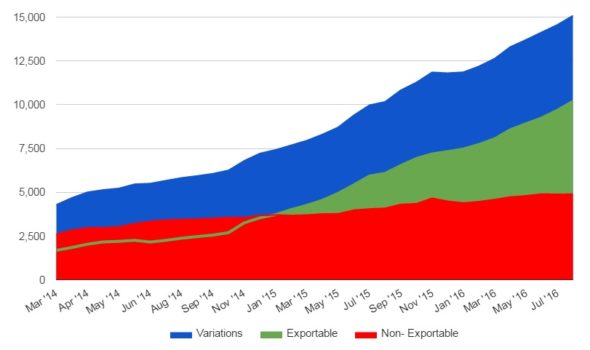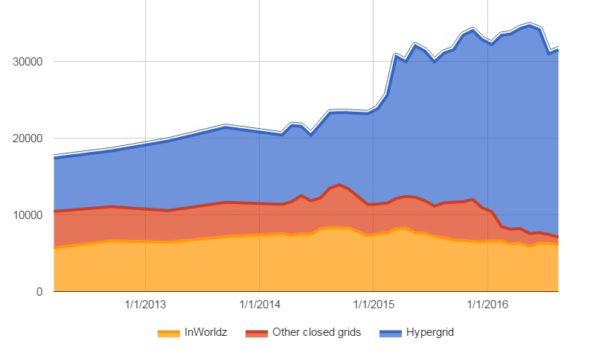Despite the the absence of the Virtual Life grid and Avination in this month’s statistics, region counts, registered users, and active users all increased this month.
Virtual Life grid shut down without notice, and Avination is in the process of moving to a new hosting provider and could be down for another month.
The land area of the active public OpenSim grids now totals the equivalent of 63,286 standard regions, an increase of nearly 4,000 regions compared to last month. Registered users went up by more than 4,000, to 480,834, and actives increased by 439 to 31,609.
The biggest land gainer was the non-profit OSgrid, which grew by 1,027 regions. Metropolis, another non-profit, gained 458 regions, and the commercial on-demand Kitely grid grew by 303.

For those who are new readers, OpenSim is a free, open source virtual world platform that’s compatible with the Oculus Rift. It allows people with no technical skills to quickly and cheaply create virtual worlds, and then teleport to other virtual worlds. Those with technical skills can run OpenSim worlds on their own servers for free, while commercial hosting starts at less than $5 a region — compared to $300 a region for the same land in Second Life.
A list of hosting providers is here. Download the recommended Firestorm viewer here. And find out where to get content for your OpenSim world or region here.
Popularity
When it comes to general-purpose social grids, especially closed grids, the rule of thumb is: the busier, the better. People looking to make new friends look for grids that already have the most users. Merchants looking to sell content will go to the grids with the most potential customers. Event organizers looking for the biggest audience… you get the idea.
Avi Brasil, the new commercial social grid from the company behind AviWorlds, gained 369 active users, bringing it to 375. AviWorlds itself lost 66 users, for a new total of 201 actives. Some may have moved to Avi Brasil, while others might have been distracted by the recent technical and communications problems suffered by Avi-Labs, the hosting company behind both grids. The two grids are now offering free regions to users, however, and both land area and active users may go up next month.
DigiWorldz came back from last month’s loss with a gain of 125 new active users. The grid has also had technical issues this summer, but reacted promptly and appropriately to solve the problems and communicate with its residents. The grid has gained users almost every month since its launch last spring, and was on the of the fastest-growing grids last year.
OSgrid gained 110 active users.
Top ten most popular grids:
- InWorldz: 6,117 active users
- OSgrid: 3,406 active users
- Metropolis: 3,131 active users
- Island Oasis: 1,654 active users
- DigiWorldz: 1,468 active users
- Great Canadian Grid: 1,370 active users
- Kitely: 1,173 active users
- Lost Paradise: 1,156 active users
- Craft World: 931 active users
- Baller Nation: 931 active users
- AllCity: 608 active users
Some grids were also better than others at bringing in new residents. InWorldz, a popular first step for Second Life users moving to OpenSim, reported 2,166 new registrations over the past 30 days. However, its active users fell by 177.
Kitely reported 1,770 new registrations, Virtual Brasil reported 571, and the Adult Grid had 550.
Meanwhile, the hypergrid as a whole is beginning to function more and more like one large grid, with an increasing number of multi-grid events, communities, and groups.
In fact, InWorldz now accounts for 86 percent of all active users on the closed grids. The 46 other closed grids have just 969 active users between them, the first time this number has dropped below 1,000 since I started keeping track in March 2012.
A closed grid is one that does not allow its users to travel the hypergrid. Closed grids also typically run all the regions on their grids, while open grids like OSgrid, Metropolis, and Atek allow users to connect regions run by third-party hosting companies, or that they host themselves on home computers.
In the past, most commercial grids were closed but recently more and more grids have turned on hypergrid connectivity and enabled filtering of content, so that creators who want their products to stay on that grid can have that option.
Kitely Market
The Kitely Market, OpenSim’s main commercial marketplace, hit new heights this month, with 8,006 products, and 15,084 product variations — 10,191 of which were exportable to other grids.

The Kitely Market currently delivers to more than 138 different OpenSim grids, both closed and open.
The Kitely Market allows merchants to group multiple variations of a product under the same listing. Those variations could be different colors, sizes, payment options, prices, or permissions. So, for example, a merchant could offer the same item for export to other grids at a different price.
As merchants have become more and more comfortable with selling content to the hypergrid, the number of exportable items has been climbing, while growth in items that are non-exportable and can be used only on the Kitely grid has leveled off.
All hypergrid-enabled grids, by default, can accept Kitely Market deliveries unless they specifically configure their grid settings to keep these deliveries out. Grids that are not accessible via the hypergrid can still accept Kitely Market deliveries, if they choose, by following these instructions.
A note on statistics
I’ve been trying to automate more and more of the data gathering, in hopes of making fewer typing and copying mistakes and speeding up the data-gathering process as the number of grids increases. However, since all the grids display data in non-standard formats, this requires hard-coded screen-scraping — and if a grid changes its layout, the screen-scraping breaks.
In addition, some grids have stats pages that I can’t figure out how to pull data from automatically. Those grids include Metropolis, Virtual Worlds Grid, Lost Paradise, Koeberle, JamGrid, AviWorlds, SLFDGrid, FreeLand, FarWorldz, Nemesis 3D, ZanGrid, Tangle Grid, Crystal’s World, Revenge of Blood, Atek Grid, Refuge Grid, Your2Live, WestWorld Grid, CreaNovale Grid, YrGrid and 2Worlds2Go.
Metropolis uses commas as thousands separators, which my computer can’t figure out. JamGrid shows zero active users — even though there are several people logged in right now. FarWorldz, Nemesis 3D, Refuge Grid, and Tangle Grid put the number of standard region equivalents on the page in a way that I can’t pull out without rewriting the script. Other grids generate the code for the numbers in such a way that it doesn’t show up in the HTML.
For an example of a great stats page, check out Great Canadian Grid’s info. The key numbers I’m interested in are the computed total regions, the total registered users, and the unique visitors from the last 30 days. The stats are on a page by themselves, so I don’t have to wait for the splash screen graphics to load. The data is clearly described and if you look at the HTML code, it’s nice and clean and easy to scrape.
There are many reasons why grids should publish their numbers. Most obviously, you get new inbound links every month, which is good for improving your search engine results. Second, it shows people are the grid is active and isn’t some abandoned, dead grid. Yes, every grid will have some bad months and some good months, but if you start out with a low number one month it’s easier to show high growth the next. Â New grids especially can quickly rack up nice growth rates if they remember to put up the numbers when they are still low.
If a grid has had some bad months, and stops publishing its stats, it’s like a giant neon sign that says, “we’re giving up.” A grid that keeps publishing them is saying, “we’re hanging in there, and we’re working to make things better.”
By offering a pared-down, clean stats page it makes it easier for me and for the other folks who want to gather these numbers.
Finally, the stats show that OpenSim is growing, which attracts more people to the platform. That’s good for all grids. Even if you only have a handful of users, your numbers do add up.
If you update your stats page, or the numbers that I’m pulling in are incorrect, please let me know, at maria@hypergridbusiness.com.
Transitions
We added five new grids to our database this month: Poqpoq, Ventureworldz, Sector 17, the space-themed grid Trans Sidera, and the religious grid Fellowship.
The following 56 grids were marked as suspended this month: 4Addiktion Grid, Allegro, Anda World, Ardalia, Austria Grid, Avares, Avination, Bearly a Grid, C4 OpenSimulator, Cyber Life, CyberFace, DigiSoul, DIY, Eureka World, Fantasy World, FNV, Galaxylandia, Genesis, Habitat7, Hiro’s PC, IEK, Italiani at Reading, Kotori, MagicForest, Majickal Network, MajWorld, Matrix, Micachee 1, Montefiorino, Nichtort, NurbsHouse, Paradise World, PeerWorld, Pixel Planet, Planet Einstein, Psychedelia, R5Academy, Relaxing in Moonlight, Serenity, SilverSky, SimValley, Six Sides Grid, SkyLife, Stray Cats-The Game, SuziWorld, Twilight Grid, Tyland, UniSA OpenSim, United Kingdom, University of Cincinnati OpenSim Virtual Campus Grid, Virtual College of The Siskiyous, Virtual Designers World, Virtual Dream, Virtual Photography Gallery, XTR-13, and Yugen World.
Some of these grids may have been down due to the summer holidays and will be back up next month.
Grids that have been suspended for more than two months will be marked as closed. If your grid isn’t on the active grids list, and not on the suspended list, and is marked closed when it shouldn’t be, please let us know.
And if there’s a public grid we’re not tracking, please email us at editor@hypergridbusiness.com. There’s no centralized way to find OpenSim grids, so if you don’t tell us about it, and Google doesn’t alert us, we won’t know about it.
By “public,†we mean grids that allow hypergrid visitors, or have a website where people can register for or request accounts.
August Region Counts on the Top 40 Grids
The list below is a small subset of existing OpenSim grids. We are now tracking a total of 1,168 different publicly-accessible grids, 278 of which were active this month, and 203Â of which published their statistics.
All region counts on this list are, whenever available, in terms of standard region equivalents. Active user counts include hypergrid visitors whenever possible.
Many school, company or personal grids do not publish their numbers.
The raw data for this month’s report is here. A list of all active grids is here.
- OSgrid: 17,281 regions
- Kitely: 12,911 regions
- Metropolis: 5,280 regions
- Atek Grid: 4,447 regions
- Lost Paradise: 3,548 regions
- DigiWorldz: 2,255 regions
- InWorldz: 1,462 regions
- AviWorlds: 1,410 regions
- Virtual Worlds Grid: 971 regions
- Great Canadian Grid: 952 regions
- Lost World: 920 regions
- StarLight World: 793 regions
- Virtual Highway: 721 regions
- Loff Virtual Worlds: 593 regions
- Virtual Brasil: 438 regions
- 3rd Rock Grid: 392 regions
- A Life Virtual: 362 regions
- The Adult Grid: 347 regions
- ZetaWorlds: 345 regions
- Open Virtual Worlds: 320 regions
- Virtual Life Brasil: 309 regions
- Tangle Grid: 298 regions
- Baller Nation: 280 regions
- Littlefield: 248 regions
- Encitra Home Grid: 236 regions
- Island Oasis: 223 regions
- FrancoGrid: 217 regions
- GerGrid: 211 regions
- SirinHGpole: 206 regions
- Craft World: 205 regions
- YrGrid: 205 regions
- ZanGrid: 191 regions
- DreamNation: 190 regions
- Grid Nirvana: 184 regions
- Neverworld: 181 regions
- Anettes Welt: 179 regions
- Logicamp: 179 regions
- Japan Open Grid: 153 regions
- AweSim Worlds: 136 regions
- AllCity: 128 regions
- Kitely Mega Worlds on sale for $90 per month - July 19, 2024
- OpenSim regions up, actives down with summer heat - July 15, 2024
- People think AIs are conscious. What could this mean for bots in OpenSim? - July 12, 2024

